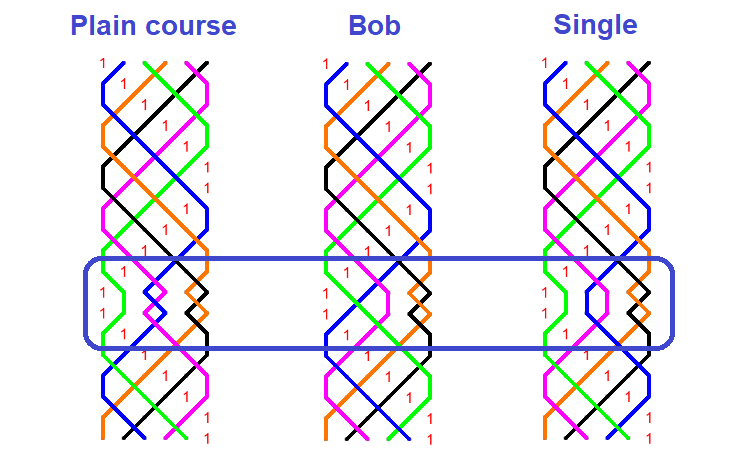Handbell Toolbox
3. Ringing your first method
3.3. Ringing touches
The effect of the bob
Everybody rings plain hunt until the treble leads. If no bob is called then a (x12) block is rung and you continue ringing Plain Bob. If a bob is called the (x12) at the lead end is replaced by a (x14). The treble and the bell in fourth place remain in position (make places in 1 and 4 at handstroke and backstroke) whilst the bells in 2/3 cross (plain hunt) and those in 5/6 dodge (as in Plain Bob).
The effect of the single
Again, everybody rings plain hunt until the treble leads. If no bob is called then a (x12) block is rung and you continue ringing Plain Bob. If a single is called the (x12) at the lead end is replaced by a (x1234). The front four bells remain in position and make places in 1, 2, 3, 4 at handstroke and backstroke, whilst the bells in 5/6 dodge (as in Plain Bob).
At the lead end, make the shape and pick up or continue with one of the three minor plain hunt patterns.

Picking up your new position
You never change the position you're ringing unless there is a block change and even then it's not necessarily true that you change positions even then. When the new block is introduced, such as the lead end (x12) block in Plain Bob or the (x14) block when a bob is called you only change position if your bells do different things:
- If both of your bells dodge – you stay in the same position.
- If both of your bells make a place – you stay in the same position.
- If both of your bells hunt – you stay in the same position.
- If one of your bells dodges, makes a place or hunts whilst the other does something else – you change position.
How do you know what this new position is? Well you note where you bells strike in the change and relate those two places to one of the positions and ring this new position going forward. There is no ambiguity – each position has unique pairs of places. So if you strike in third and fifth place, you can only be in coursing position, and if you strike in seconds and fifths place, you must be in opposites position.
Why ring touches?
A plain course of Plain Bob Minor is five leads or 60 changes long. Bobs and singles are introduced at the lead end to vary and increase the changes rung – adding variety and length.
Thinking of blocks of changes, the (x12) at the Plain Bob lead end is replaced by a (x14) for a bob and a (x1234) for a single.
The bob or single is called when the treble strikes in seconds place whilst hunting down to the lead.